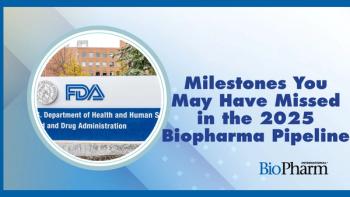
Weighing Digitalization Efficiency Against Upskilling and Quality Concerns
Key Takeaways
- AI and digitalization are transforming the biopharmaceutical industry, necessitating workforce upskilling to address the skills gap.
- Transitioning to digital records enhances efficiency and quality, but requires data cleansing and a solid data foundation.
With artificial intelligence and digital technologies transforming the CDMO space, industry leaders at CPHI Frankfurt shared their successes and identified pitfalls.
The annual, worldwide CPHI conference,
Much of that change—
But another shift with global implications also persisted as a common theme: the upskilling of workers amid the emergence of artificial intelligence (AI) platforms and further digitalization along all points of the drug development lifecycle.
“The greatest potential for innovation lies with AI,” says
Throughout the year, PharmTech Group asked questions in dozens of interviews relating to the widening skills gap created by rapid digitalization, and the push to attract and retain top talent. The following is a sampling of incisive, insightful responses from CPHI Frankfurt.
What don’t we know that we don’t know?
For
“This skills gap is a real challenge, and the trainings are also not very well defined,”
“There's an inconsistency around the state of digitalization, and not just company-to-company, but asset-to-asset within companies, because different assets have different ages and different ability to support digitalization,” Dowdeswell says (5). “Innovation, the lack of standardized data architecture, is something that we've seen, really in a microcosm, but [also on] a macro level [and] is something everybody faces.”
And because how much there is still left to be discovered is open-ended, Dowdeswell cautions that there is another problem: the current relative lack of availability of expertise.
“Is there a suitably qualified workforce?” Dowdeswell asks (5). “Do we have access to the right people who can really support and drive digital initiatives, and, in fact, even who fully understand the true potential of what could be done? I think that's one of the key challenges that, as an industry, we're still coming to grips with.”
How can the paper trail be shortened?
An area in which there has been measurable success—literally, by the pound—in implementing digitalization is the ability to transfer paper records online.
That isn’t as easy as it may seem, however;
“This difficulty can make it challenging for organizations to defend the investment, as they are often looking for the ROI as quickly as possible,” Mowery says (3). “This situation is comparable to the introduction of electronic batch records: converting poor paper records to a digital format simply results in a poor digital format. Therefore, companies must undertake the ‘housekeeping and cleanup’ to establish a solid foundation, focusing on data cleansing, data hygiene, and creating a good, solid data lake before they can fully realize the benefits of AI.”
Once at that point, though, according to
“The world of regulatory and quality has a tendency to be very heavy on the paperwork side of things,” Romanski explains (6). “And if you're not leveraging the digital technologies that we have today, I think it's a missed opportunity. What we have done is we've taken a lot of our paperwork that [is] needed for our clients, with which to interact with regulatory authorities, quality agencies, etc., and we've put that all online. And this enables people to have a one-stop shop, [you] don't need to call somebody on the phone, you don't need to use a fax machine or some of these technologies that are long outdated. You can get everything online. It's always up to date. You get notifications when things change.”
How do CDMOs ensure quality?
As Romanski indicates, migrating all of a company’s data online doesn’t just have the objective of keeping a tidy house. The endeavor can be a model for other processes and relationships an organization undertakes.
“We continue to really focus on the processes that we have,” Romanski says (6). “We document everything that's there. And once you get downstream and you start talking about the CDMO sites that we manage, this is something that's, of course, absolutely critical to what we're doing. We really embed quality into every step of our manufacturing processes, all of the interactions that we have with our clients, and with any agencies that they're in.”
And while AI can streamline some processes, it has also contributed to making others more detailed in the name of higher quality, according to Dowdeswell.
“I have some data that shows around the year 2000, there was a paper published by Pfizer and AstraZeneca that showed the average number of synthetic steps to get to an API was eight,” he explains (5). “Earlier this year, I found some more data, which suggested that the new molecules coming out of novel approaches to drug discovery have often in excess of 30 steps of chemistry to get to the target. So that is a really dramatic step change—that over the past 25 years, you've gone from eight to 30 steps, and that's quite an unexpected consequence. CDMOs are going to have to find a way to deal with that.”
Mostafa suggests that trial-and-error is almost a requisite component of AI implementation.
“A lot of companies have spent a significant amount of money to build their own systems for digital transformation, often with mixed success,” she says (4). “It is important to build small successes and demonstrate to the organization that this can create efficiency. It is also crucial to understand how the data structure will work out so that historical data can be taken advantage of when implementing AI into manufacturing.”
What’s next?
When it comes to preparing the next generation, many of whom may be navigating the ethics of AI in their college classes right now, for these seismic changes in workflows, Mostafa says higher education is trying its best to stay ahead of the game.
“We are seeing very good programs being created in a lot of universities that have biomanufacturing master’s programs, where trainings are being given,” Mostafa says (4). “These trainings cover not just hands-on manufacturing, but also a lot of these digitalization tools. We also see that [many] of the larger tech companies are getting into the health sector, and they are creating many training opportunities. There are certainly a lot of training options available online. Some of it has to be self-training for people, but each company now has a responsibility to upskill the training of their staff.”
For Romanski, upholding reputations that CDMOs have burnished over a number of decades remains a top priority, no matter what technology is being used.
“As we're producing our products and our services, we're always building quality by design into those products themselves, and we're leveraging a tremendous amount of technology to make sure that we are consistent always with those highest standards,” he says (6).
References
1. Lavery, P.
2. Lavery, P.
3. Cole, C.
4. Mirasol, F.
5. Haigney, S.
6. Lavery, P.
Newsletter
Stay at the forefront of biopharmaceutical innovation—subscribe to BioPharm International for expert insights on drug development, manufacturing, compliance, and more.





